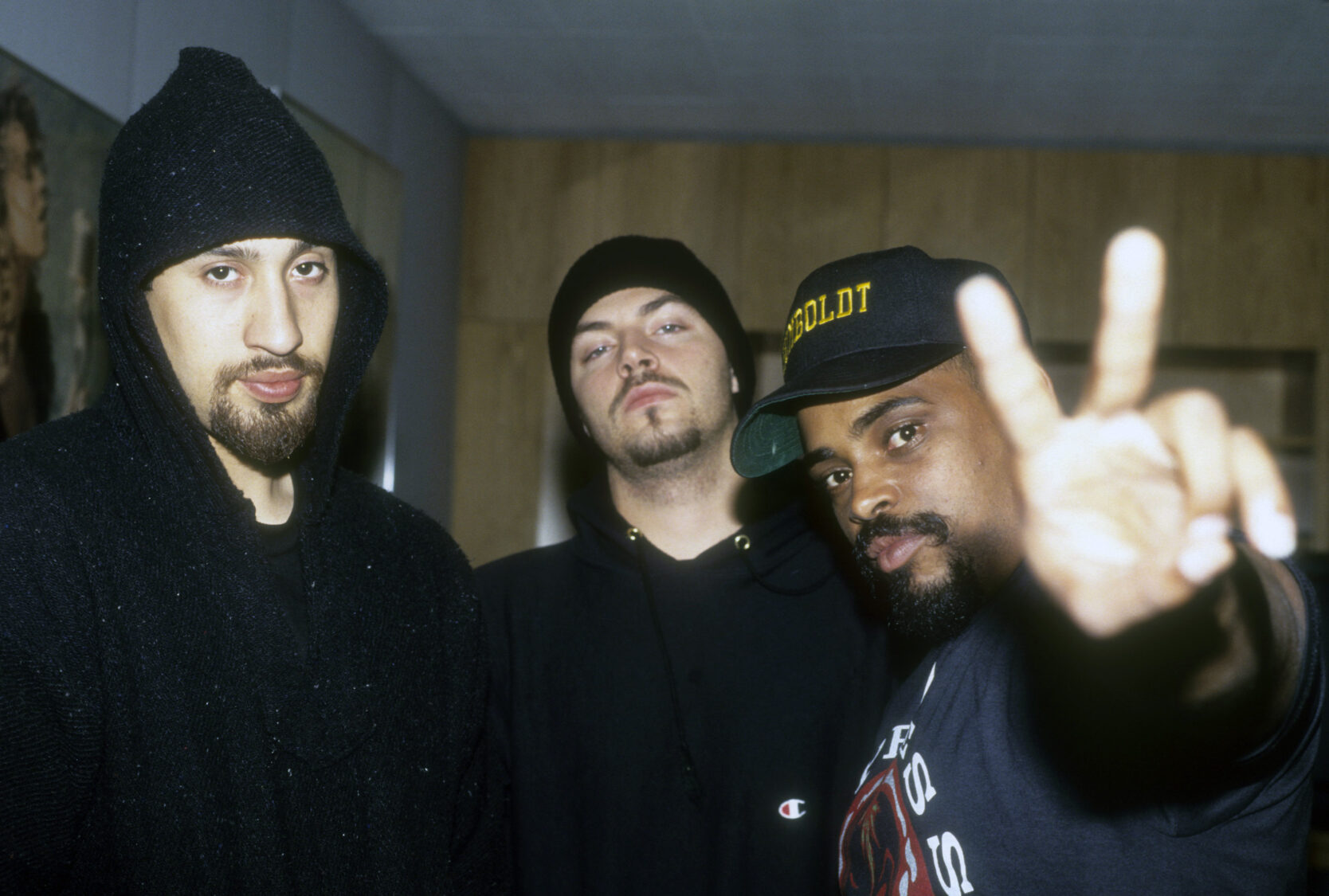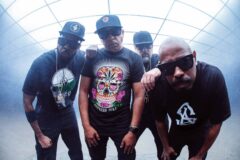You know the sound: DJ Muggs drops a beat that seems to contain both the deepest bass ever heard and piercing sirens, B-Real’s nasal voice cuts through the track, and Sen Dog bellows hooks in his signature “psycho beta” voice. Whether the group is espousing the benefits of recreational marijuana use on “I Wanna Get High” or telling violent tales of street life on “Hand on the Pump,” Cypress Hill has helped shape the musical identity of Black and brown Los Angeles for more than three decades.
Cypress Hill has endured its ups and downs over the years, with both Sen Dog and DJ Muggs taking leave from the group for a few years here and there. Over the course of 10 studio albums and several other projects, however, the trio has kept coming back together to deliver some of hip-hop’s most gloriously stoned anthems and ominous basement bangers. Along the way, they’ve peppered metal guitars, Spanish lyrics, spacey jazz samples, mischievous humor, and defiant activism into their songs, creating an immediately recognizable and influential brand.
July 20 marks the 30th anniversary of Cypress Hill’s massively popular second album, Black Sunday, but does it still stand up as its very best?
12. Rise Up (2010)
Since 2004, DJ Muggs has stepped away from Cypress Hill to focus on other projects for long stretches, although he periodically returns to the group. And though Muggs co-produced two tracks on Rise Up, it suffers from being the first album not primarily produced by the architect of the Cypress Hill sound. B-Real, who’d just released his solo debut Smoke n Mirrors, steps up and produces a few beats with mixed results, while Rage Against the Machine’s Tom Morello, Linkin Park’s Mike Shinoda, and System of a Down’s Daron Malakian produce tracks that expand on the rap/rock experiments of Skull & Bones. The album’s best song, “Armada Latina” featuring Pitbull and Marc Anthony, unites an unlikely trio of Latino icons over a smooth Crosby, Stills & Nash sample. “As much as B-Real still seems lively, Sen Dog seems to have smoked himself out of being a rapper. He sounds exhausted and unimaginative all over this record,” wrote Saxon Baird in a PopMatters review.
11. Live at the Fillmore (2000)
Some of the biggest rappers have never bothered to make live albums, but few hip-hop acts have built their fanbase off of touring as much as Cypress Hill. Recorded at the historic San Francisco venue, Live at the Fillmore captures the group at the height of their powers. B-Real and Sen Dog’s unparalleled ability to command a crowd and lead call-and-response chants is displayed amply on the 10-minute medley of “Pigs” and “Looking Through the Eye of a Pig.” Percussionist Eric “Bobo” Correa, who became a permanent member of Cypress Hill in 1993, gives early tracks like “How I Could Just Kill a Man” a boost of energy and texture with timbales and congas. “This strikes the right balance between a reasonably polished recording and something that doesn’t lose the raw live vibe,” wrote Derek Bardowell in an NME review.
10. Stoned Raiders (2001)
A year after the new approach of Skull & Bones, Cypress Hill moved back towards an old-fashioned collection of beats and rhymes on Stoned Raiders. “Red, Meth & B” with Redman and Method Man is a historic summit of hip-hop’s favorite potheads, and “Kronologic” with Kurupt packs the entire Cypress Hill story into a five-minute song. Like many rap albums of its era, however, it doesn’t sustain the excitement of its collaborations on the songs without guests. “Stoned Raiders doesn’t break much with the vibe and lyrical content of its predecessors, but on the production side, DJ Muggs throws in a handful of generally effective stylistic curveballs,” Nathan Rabin wrote in an AV Club review.
9. Los Grandes Exitos En Español (1999)
At the end of a decade of reigning as the most successful Latin rap group of the 1990s, albeit with predominantly English lyrics, B-Real and Sen Dog decided to spit some of their most famous verses in Spanish. Greatest hits albums with re-recorded songs are rarely worth a listen, but Los Grandes Exitos En Español is an interesting exercise that casts songs like “Insane in the Brain” (“Loco En El Coco”) in a new light while showing love to the rappers’ roots.
8. Back in Black (2022)
Black Milk, a Detroit rapper/producer who rose to fame with solo albums and work with artists like Slum Village and Danny Brown, may not have been the most obvious choice to produce the most recent Cypress Hill album. B-Real and Sen Dog sound revitalized by the presence of a new collaborator on their most recent album, though, and Black Milk digs deep into the crates for some sample-driven bangers that help fill the void of DJ Muggs’ absence. At 32 minutes, Back In Black is Cypress Hill’s shortest album, doing away with skits and interludes for a brisk, enjoyable ride. “You may think Cypress Hill have uttered everything they could possibly have to say about getting high, but you’d be wrong,” George Garner wrote in a Kerrang! review.
7. Cypress Hill IV (1998)
Cypress Hill’s increasingly murky and artsy sound on IV may be what led British trip-hop pioneer Tricky to draft DJ Muggs to contribute to his 1999 album Juxtapose. “Dr. Greenthumb” introduced an entertaining new B-Real alter ego with one of Cypress Hill’s most sonically distinctive singles, and the punchy “Checkmate” is one of its best tracks where Sen Dog takes the first verse. IV continued the group’s downward commercial slide, though, becoming its first album to fall short of platinum sales, and forgotten protégé Barron Ricks gets far too many guest verses. “While B-Real’s stoned singsong rapping and DJ Muggs’ ear-catching production tricks remain formidable, IV feels unnecessarily oppressive, its grim messages only occasionally leavened with flashes of the old humor,” Tom Sinclair wrote in an Entertainment Weekly review.
6. Skull & Bones (2000)
Cypress Hill spent much of the ‘90s touring with rock bands, but aside from its Pearl Jam and Sonic Youth collaborations on the genre-mixing Judgment Night soundtrack, it never really made rap-rock at the time. That changed when it staged a platinum comeback with Skull & Bones, sending the single “(Rap) Superstar” to hip-hop radio and “(Rock) Superstar” to alternative radio – and landing a bigger hit with the latter. Skull & Bones is a classic double album gambit: disc one features the group’s classic sound, while disc two dabbles in nü-metal. What makes the album work is that the second disc is much shorter than the first, with six guitar-driven tracks that give Skull & Bones a high-energy finale without wearing out their welcome.
5. Till Death Do Us Part (2004)
There’s a little more reggae bounce in Till Death Do Us Part than Cypress Hill’s other albums, but mostly it’s a return to form for DJ Muggs, with some of his thickest grooves since the group’s ‘90s heyday. “Busted in the Hood” is an entertaining riff on “Paul Revere” by Cypress Hill’s old friends the Beastie Boys, and it’s exciting to hear B-Real go toe-to-toe with another iconic MC, Prodigy of Mobb Deep, on “Last Laugh.” “’Latin Thugs’ is an excellent party jam that spotlights the unique reggae-infused raps of rising Puerto Rican star Tego Calderon over an explosive horn sample. Unfortunately, other attempts at genre-mashing suffer from some uncharacteristically sluggish Muggs production,” wrote Hua Hsu in a Blender review.
4. Cypress Hill III: Temples of Boom (1995)
Cypress Hill was at the height of its fame in 1995 when the group dropped its most divisive album. III: Temples of Boom’s woozy midtempo beats played well with the group’s stoner faithful, but failed to generate a radio hit, and the album only sold a fraction as much as its predecessors. The best songs, “Illusions” and “Boom Biddy Bye Bye,” derive a dreamy aura from samples of jazz vibraphonist Gary Burton. “No Rest for the Wicked” also ignited a feud with one-time friend Ice Cube that would take years to resolve. “Cypress Hill’s stoned slowness on Temples of Boom is definite proof that hemp demolishes brain cells. Middle-of-the-road and lame-in-the-membrane is how Temples hits me,” Chuck Eddy wrote in the SPIN review.
3. Elephants on Acid (2018)
For much of the 2010s, Cypress Hill’s co-founders focused on other projects: B-Real formed Prophets of Rage with Chuck D and Tom Morello, Sen Dog fronted the metal band Powerflo, and DJ Muggs made albums with underground rap heroes like Roc Marciano and Mayhem Lauren. When they reconvened for the first Cypress Hill album in eight years, the trio sounded refreshed and inspired. If Temples of Boom was ahead of its time in 1995, Elephants on Acid represents Cypress Hill at its most psychedelic at a time when its fanbase was better prepared to understand these slowest, weirdest grooves. “Muggs pulls every disorienting trick out of the carpetbag: sitars, sub bass, trumpeting pachyderms, and dubby contributions by psych outrider Gonjasufi,” wrote Kitty Empire in The Guardian.
2. Cypress Hill (1991)
The group originally known as DVX formed in L.A. in 1988, just as N.W.A’s Straight Outta Compton was putting West Coast hip-hop on the map. By the time its debut album hit stores three years later, the Cypress Hill sound and identity arrived fully formed: B-Real’s sharp, nasal delivery and Sen Dog’s echo chamber refrains (“Hole in the Head“), odes to weed (“Stoned Is the Way of the Walk”), gangsta posturing (“How I Could Just Kill a Man”), and Spanglish slang (“Latin Lingo”). America very quickly fell in love. “Nothing since the early Eazy-E 12 inches has made the hardcore life seem so entertaining,” Jonathan Gold wrote in the Los Angeles Times review.
1. Black Sunday (1993)
Cypress Hill’s debut was a sleeper hit, never rising above No. 31 on the Billboard 200 but going platinum over a year after release. That word-of-mouth groundswell translated into an explosive debut for Black Sunday, which hit No. 1 with 261,000 copies sold, the largest number of units moved by a rap album in one week since SoundScan began tracking sales in 1991. “Insane in the Brain” is the moshpit-ready anthem that made the group unlikely crossover stars, but Black Sabbath samples and foreboding graveyard-themed cover art gave Cypress Hill the badass stoner cachet to make Black Sunday as common in dorm rooms as gravity bongs and black lights. “Unlike the densely layered masterworks of superproducers like Dr. Dre or the Bomb Squad, Muggs rules the realm of sinister minimalist funk. With rarely more than a raw beat combined with a thumping piano-bass loop and a siren-like wail, Muggs creates a skeletal groove that allows B-Real and Sen Dog’s vocal pyrotechnics to stand out,” wrote Matt Diehl in a Rolling Stone review





